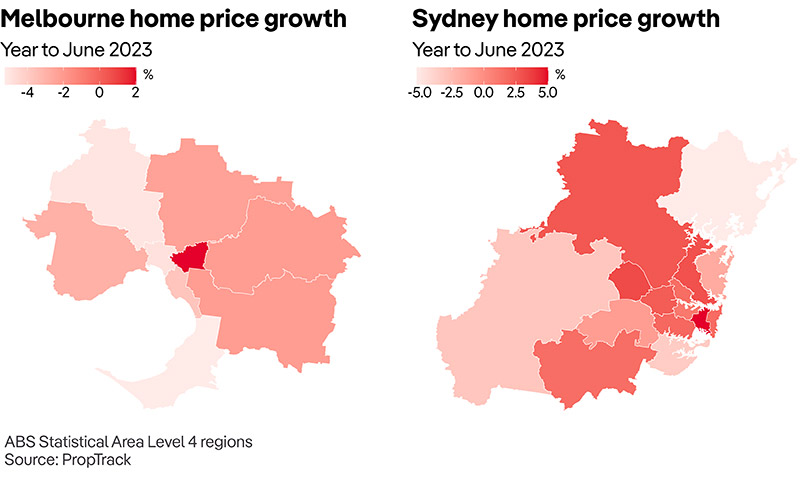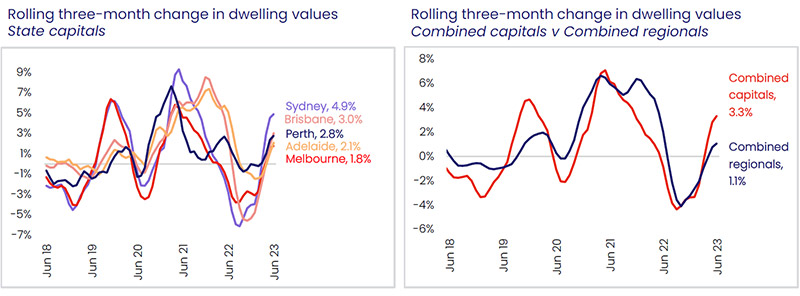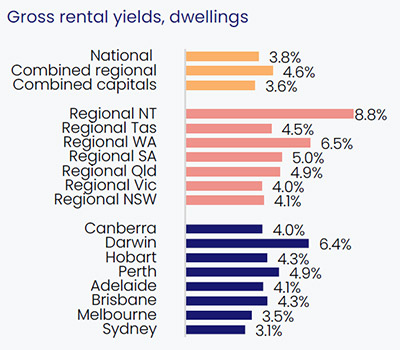Property prices continue recovery but headwinds lurk
Australia's property market has clocked up a fourth straight month of home value increases, with Sydney again leading the way, but there may be headwinds lurking.
Australia’s property market recovery has continued ticking along courtesy of a fourth consecutive month of housing value increases.
A lack of supply is outweighing the countering influence of rising interest rate and cost of living pressures, with every capital city outside Hobart (-0.3 per cent) recording gains. Regional markets outside Victoria have also trended higher.
Prices in June rose 1.1 per cent, a slight drop on the 1.2 per cent of May.
Sydney was again the frontrunner, lifting another 1.7 per cent in June and taking the cumulative recovery since the January trough to 6.7per cent, according to CoreLogic’s newly released national Home Value Index (HVI) for June.
In dollar terms, Sydney’s median housing values are rising by roughly $4,262 a week.
According to CoreLogic, since finding a floor in February, the national measure of housing values has gained 3.4 per cent, however, the market remains 6.0 per cent below peak levels recorded in April 2022. That is the equivalent of the median dwelling value still being -$45,771 below a peak of $768,777.
CoreLogic’s research director, Tim Lawless, said the number of capital city homes advertised for sale over the four weeks ending 25 June was almost 20 per cent lower than at the same time last year and 26 per cent below the average for this time of the year. Regional listings also trended lower through the month, tracking a massive 33 per cent below the previous five-year average.

Source: Corelogic.
Higher interest rates were, however, slowing the pace of national property price gains.
“A slowdown in the pace of capital gains could be a reflection of a change in sentiment as interest rate expectations revise higher,” Mr Lawless said.
“Higher interest rates and lower sentiment will likely weigh on the number of active home buyers, helping to rebalance the disconnect between demand and supply.”
Deflationary property pressures are building
Also weighing on the market more and more each month is the mortgage cliff.
Helen Avis, Director of Finance at Specialist Mortgage, Australia's mortgage market is experiencing and confronting a significant shift.
“Starting during the 2020 pandemic, there was a boom in fixed-rate borrowing as lenders slashed their fixed rates to record-low levels and many borrowers took advantage.
“At the peak, almost 40 per cent of outstanding home loans in early 2022 were fixed, which was roughly twice their usual share from prior to 2020.
“As of March 2023, about 25 per cent of fixed-rate loans outstanding in early 2022 had expired.
“By the end of 2023, another 40 per cent will expire; and by the end of 2024, another 20 per cent and presenting what has been dubbed the ‘fixed-rate, or mortgage, cliff’,” Ms Avis said, pointing out that it could play out in stifled property price pressure.
Ms Avis added that it was a good time to refinance.
“There’s a reason refinancing is at record levels and that’s because there’s significant money to be saved by doing so.”
A sign of potential trouble on the horizon is the fact the proportion of loss-making resales that were held for less than two years has trebled since late 2021, while the risk of recession from higher interest rates also weighed heavily.
Another key risk for housing conditions is the potential for a rise in advertised housing stock.
“Low inventory levels have arguably been the most important factor placing upwards pressure on housing prices,” Mr Lawless said.
“A change in the supply dynamic could become evident in spring, when the flow of listings would typically ramp up.
“We could also see more listing flow onto the market if mortgage stress becomes widespread.”
Home values nearing peak levels
Research from PropTrack released this weekend differs from CoreLogic (with a more modest 0.3 per cent national home price jump for the month) but also has prices in the black across the capitals and just 0.1 per cent lower than this time last year.
PropTrack found Sydney home prices had continued their recovery in June after leading the downturn in 2022.
Sydney home prices have now increased for seven straight months, with a 0.6 per cent rise in June. That means home prices are now up 4.5 per cent from their trough in November last year and are just 3 per cent below their February 2022 peak.

Melbourne by comparison had increased 0.2 per cent in June, bringing the city up 0.8 per cent from its low in January this year.
While Melbourne has not seen as sharp a recovery in prices this year as Sydney has, it also did not see as large a decline in 2022. Even so, prices in Melbourne are still 5.2 per cent lower than their peak in March 2022.
Across the capital cities, Perth is the only capital where home values are at record highs, having recovered from the relatively mild 0.9 per cent decline through the downturn, according to CoreLogic.
Adelaide home values are only 0.3 per cent below record highs and likely to reach a new high point in July.
Regional housing values have also trended higher, albeit at a slower pace relative to the capitals.
The combined regionals index also recorded a fourth consecutive month of growth, taking housing values 1.2 per cent higher than the recent low in February.

Source: Corelogic.
Mr Lawless said the softer growth trend across regional areas of the country align with recent shifts in demographic factors.
“After regional population growth boomed through the worst of the pandemic, internal migration trends have normalised over the past year, resulting in less housing demand across regional markets.
“Additionally, housing demand from overseas migration is skewed towards the capital cities rather than the regions.”
Rents still climbing amid signs of a slowdown
Rental conditions remain diverse across the nation, but there is growing evidence rental growth is easing.
The national rental index increased a further 0.7 per cent in June, still well above the pre-Covid decade average of 0.2 per cent month-on-month, but a continued deceleration and the smallest monthly rise since January 2023, according to CoreLogic.
The annual growth trend in rents was recorded at 11.5 per cent across the combined capital cities, down from a record high of 11.7 per cent over the 12 months ending April 2023.
Across the combined regional areas of Australia annual rental growth has slowed to 4.9 per cent, following the record high of 12.5 per cent over the year to September 2021.

Source: Corelogic.
Mr Lawless said the slowdown in rental appreciation can be seen in most cities and regional markets to different extents.
Canberra is the only capital to record a fall in rents over the past 12 months, down -2.8 per cent, while declines in Hobart rents over the past two months have dragged the annual trend to just 1.3 per cent. Both these markets have seen a loosening in supply and increase in vacancy rates.
“Although easing, the larger capitals continue to record stronger rental appreciation, especially across unit markets, where overseas migration and insufficient rental supply is continuing to place upwards pressure on rents.
“Rental vacancy rates have generally ticked a little higher over recent months, but remain well below average levels.”
Higher vacancy rates are most evident across regional Australia, rising from 1.3 per cent in February 2022 to 1.5 per cent in June, however, even at 1.5 per cent, the current rate is less than half the decade average of 3.3 per cent. Vacancy rates across the combined capitals have risen from 1.0 per cent earlier this year to 1.1 per cent but are holding well below the decade average of 2.8 per cent.
Some cities haven’t seen any signs of vacancy rates easing. Adelaide is recording the lowest vacancy rate at 0.4 per cent, up slightly from 0.3 per cent in early 2022. Perth’s vacancy rate is holding at 0.7 per cent and Melbourne’s is sitting at just 0.8 per cent.
“Despite such tight vacancy rates, it’s likely the trend in rental appreciation will continue to moderate, simply due to rental affordability pressures forcing a change in rental household formation.
“The early signs of a rebound in the average household size can already be seen in data published by the RBA,” Mr Lawless said.
In relation to the rental crisis, NSW’s Landcom was contacted on several occasions over the past few months for comment on the prospects of land supply increasing in the coming 12 months but failed to respond.





















